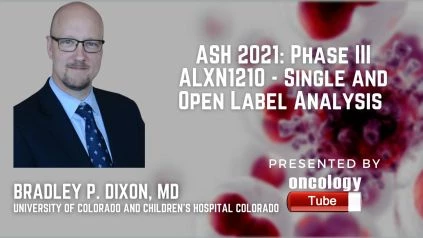Bradley P. Dixon, MD, Renal Section, Department of Pediatrics, University of Colorado School of Medicine, Pediatric Nephrologist at Children
‘s Hospital Colorado speaks about the ASH 2021 Abstract – 769 Two-Year Efficacy and Safety of Ravulizumab in Adults and Children with Atypical Hemolytic Uremic Syndrome (aHUS): Analysis of Two Phase 3 Studies.
Link to Abstract:
https://ash.confex.com/ash/2021/webprogram/Paper145040.html
Background:
Ravulizumab, a humanized anti-complement C5 monoclonal antibody created by modifying eculizumab to attain a longer half-life, has been approved to treat aHUS in the United States (2019), the European Union (2019), and Japan (2020). The results of the phase 3 studies of ravulizumab in adults and children with aHUS have been published at 26 weeks (wk) and 1 year (yr). These experiments have been followed for two years, and the results are shown below.
Methods:
Efficacy and safety data from ravulizumab clinical trials in adults naive to complement inhibitor treatment (NCT02949128) and children either naive to (nave) or switched from (switch) eculizumab (NCT03131219) were assessed at 2 years and presented alongside data from the initial 26-week evaluation periods; patients were dosed every 8 weeks (adults) or every 4 or 8 weeks (children), depending on body weight. These data were subjected to descriptive statistical analysis. There were no statistical comparisons made between the data at 26 weeks and 2 years, or between trials.
Results:
The Table shows efficacy data in adults and treatment-naive children. In both studies, more patients had a complete thrombotic microangiopathy (TMA) response (platelet count normalization, lactate dehydrogenase normalization, and a 25% improvement in serum creatinine from baseline, met concurrently at 2 separate assessments, at least 4 weeks apart) at 2 years vs 26 weeks (adult: 34 [61 percent] vs 30 [54 percent]; naive: 18 [90 percent] vs 15 [75 percent]). At 2 years vs. 26 weeks, all entire TMA response components were either numerically improved or maintained. Kidney function improved throughout time, with the median change in estimated glomerular filtration rate from baseline numerically increasing in both adults (35 vs 29 mL/min/1.73m2) and naive children (82.5 vs 80 mL/min/1.73m2) at 2 years versus 26 weeks. Most patients on dialysis at the start were able to stop at 26 weeks; this was sustained in adults (67 percent vs. 67 percent), but all naive children on dialysis at the start had stopped by 2 years (83 percent vs 100 percent ). There were no patients who began dialysis after stopping it for 26 weeks. In both investigations, the stage of chronic kidney disease (CKD) improved in the majority of patients after 26 weeks (adult, 68 percent; naive, 88 percent); improvements were maintained after 2 years (adult, 71 percent; nave, 94 percent). At the age of two, no naive children
‘s CKD stage worsened. Quality of life improved from baseline at 26 weeks and 2 years, as judged by the Functional Assessment of Chronic Illness Therapy–Fatigue (adults: 20 vs 12; nave: 10 vs 8), the EQ-5D-3L visual analog scale (adults: 32 vs 33), and the EQ-5D-3L time trade-off (adults: 32 vs 33). (adults: 0.32 vs 0.31).
The majority of adverse events (AEs) and severe adverse events (SAEs) observed in these studies occurred during the initial 26-week evaluation period, with a general decrease in the number of patients reporting any new S/AE events at 2 years. (n, percent): (n, percent): (n, percent): (n, percent): (n, percent): (n, percent): (n, percent): (n, percent): (n, percent): (n, percent): (n, percent): (n, percent): (n, percent) naive children – abdominal pain (6, 25 percent), contusion (5, 21 percent), cough (5, 21 percent), nausea (4, 17 percent), myalgia (4, 17 percent), rash (4, 17 percent), and rhinorrhea (4, 17 percent); switch children – upper respiratory tract infections (URTI; 4, 40 percent), oropharyngeal pain (3, 30 percent), pharyngitis (3, 30 percent), cough (2, 20 percent); switch children – upper respiratory tract (2, 20 percent ). After 26 weeks, no participants in either study dropped out due to treatment-emergent AEs. At any time point in either research, no meningococcal infections were found. One adult patient who had previously met complete TMA response criteria while receiving therapy chose to discontinue treatment, resulting in recurrent disease as evidenced by an increase in serum creatinine (SCr), which was then reversed when the patient restarted therapy, resulting in improvements in SCr levels.
Conclusions:
At 2 years vs 26 weeks, ravulizumab was related with numerically sustained or enhanced improvements in hematologic outcomes and kidney function in both treatment-naive adults and children. During the extension term of these investigations, fewer S/AEs were reported than during the initial 26-week evaluation periods. At any time period in either research, no meningococcal infections were reported. Long-term treatment with ravulizumab appears to be well tolerated and may be linked to continued improvements in TMA parameters and renal function in adults and children with aHUS, according to the findings.

